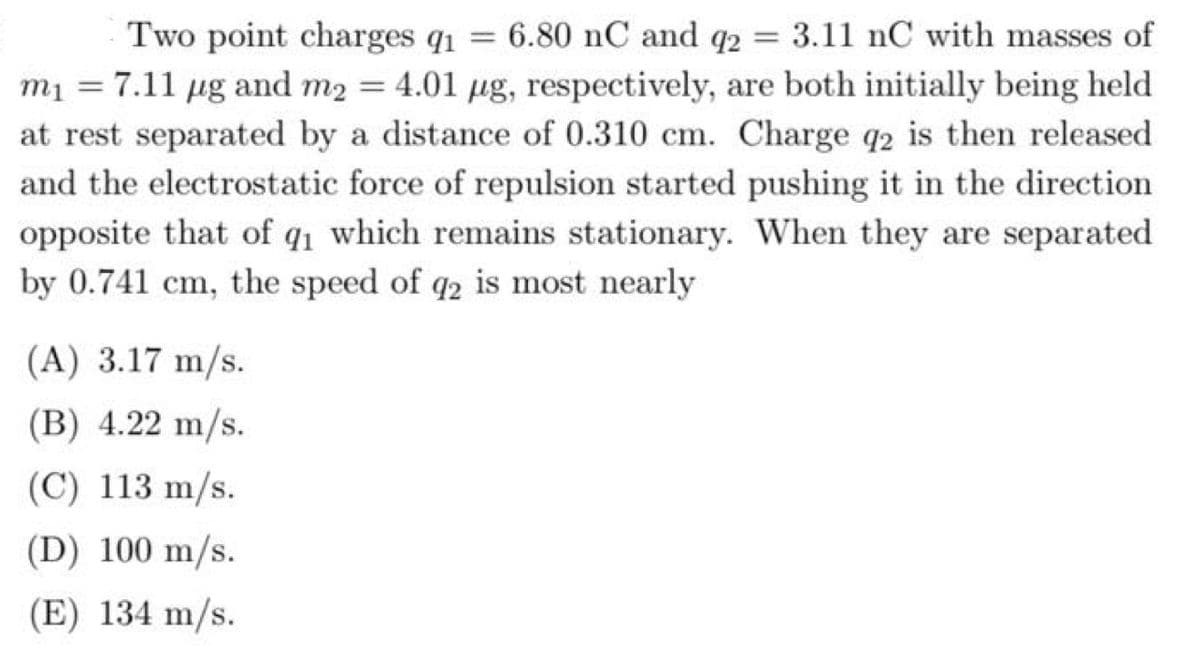Two point charges q1 = 6.80 nC and q2 m1 = 7.11 µg and m2 = 4.01 µg, respectively, are both initially being held at rest separated by a distance of 0.310 cm. Charge q2 is then released and the electrostatic force of repulsion started pushing it in the direction opposite that of q1 which remains stationary. When they are separated 3.11 nC with masses of %3D by 0.741 cm, the speed of q2 is most nearly (A) 3.17 m/s. (B) 4.22 m/s. (C) 113 m/s. (D) 100 m/s. (E) 134 m/s.
Two point charges q1 = 6.80 nC and q2 m1 = 7.11 µg and m2 = 4.01 µg, respectively, are both initially being held at rest separated by a distance of 0.310 cm. Charge q2 is then released and the electrostatic force of repulsion started pushing it in the direction opposite that of q1 which remains stationary. When they are separated 3.11 nC with masses of %3D by 0.741 cm, the speed of q2 is most nearly (A) 3.17 m/s. (B) 4.22 m/s. (C) 113 m/s. (D) 100 m/s. (E) 134 m/s.
Physics for Scientists and Engineers, Technology Update (No access codes included)
9th Edition
ISBN:9781305116399
Author:Raymond A. Serway, John W. Jewett
Publisher:Raymond A. Serway, John W. Jewett
Chapter23: Electric Fields
Section: Chapter Questions
Problem 23.3OQ: A very small ball has a mass of 5.00 103 kg and a charge of 4.00 C. What magnitude electric field...
Related questions
Question

Transcribed Image Text:6.80 nC and q2
3.11 nC with masses of
Two point charges q1
m1 = 7.11 ug and m2 = 4.01 µg, respectively, are both initially being held
at rest separated by a distance of 0.310 cm. Charge q2 is then released
and the electrostatic force of repulsion started pushing it in the direction
opposite that of q1 which remains stationary. When they are separated
by 0.741 cm, the speed of q2 is most nearly
(A) 3.17 m/s.
(B) 4.22 m/s.
(C) 113 m/s.
(D) 100 m/s.
(E) 134 m/s.
Expert Solution
This question has been solved!
Explore an expertly crafted, step-by-step solution for a thorough understanding of key concepts.
This is a popular solution!
Trending now
This is a popular solution!
Step by step
Solved in 3 steps

Knowledge Booster
Learn more about
Need a deep-dive on the concept behind this application? Look no further. Learn more about this topic, physics and related others by exploring similar questions and additional content below.Recommended textbooks for you

Physics for Scientists and Engineers, Technology …
Physics
ISBN:
9781305116399
Author:
Raymond A. Serway, John W. Jewett
Publisher:
Cengage Learning

College Physics
Physics
ISBN:
9781285737027
Author:
Raymond A. Serway, Chris Vuille
Publisher:
Cengage Learning

Principles of Physics: A Calculus-Based Text
Physics
ISBN:
9781133104261
Author:
Raymond A. Serway, John W. Jewett
Publisher:
Cengage Learning

Physics for Scientists and Engineers, Technology …
Physics
ISBN:
9781305116399
Author:
Raymond A. Serway, John W. Jewett
Publisher:
Cengage Learning

College Physics
Physics
ISBN:
9781285737027
Author:
Raymond A. Serway, Chris Vuille
Publisher:
Cengage Learning

Principles of Physics: A Calculus-Based Text
Physics
ISBN:
9781133104261
Author:
Raymond A. Serway, John W. Jewett
Publisher:
Cengage Learning

Physics for Scientists and Engineers: Foundations…
Physics
ISBN:
9781133939146
Author:
Katz, Debora M.
Publisher:
Cengage Learning

College Physics
Physics
ISBN:
9781938168000
Author:
Paul Peter Urone, Roger Hinrichs
Publisher:
OpenStax College